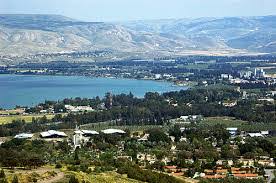
As they say, a picture is worth
a thousand words. When Rabbi Aharon Gross, Bais Yaakov’s Director of
Development, told me that the Bais Yaakov High School’s parking lot was fuller
than he’d ever seen it, I didn’t doubt him, but I was still astounded when I
saw it for myself. When I finally found an empty spot and crossed over to the
high school building, it was as if I had entered a different world: a world of
laughter, hard work, persistence, and friendship; a world where toothpicks,
dice, and medicine bottles form breathtaking mosaics; a world where glue guns,
staple guns, and black fabric are the most precious of commodities.
Stepping
gingerly through the halls, I stare in awe at the action: high schoolers gluing,
taping, and sewing; fathers building, sawing, and measuring; mothers drawing,
cutting, and stapling. It was if the entire Bais Yaakov family had converged to
make this world called exhibit a reality.
* * *
What is an exhibit? I
ask Chana Leeba Lachman, an exhibit room head. Her answer is succinct but sums
up the magnitude of the project: “We take the entire middle floor of our school and turn the
classrooms into artistic displays of our theme.” As a room head, Chana Leeba is
responsible for one classroom. First, she and her teammates research their
topic and break down the important events. Then, they brainstorm creative ways
to display the information. What supplies to use? How many supplies to buy?
Where to buy supplies? How to put it all together? These questions swirl around
the room heads’ brains for months, and when it is finally time to actualize
their ideas, they have a room full of high schoolers to delegate the tasks
to.
Adina Gross,
another room head, concurs. “Being a room head is…a lot! It’s amazing. It’s
stressful. Thank G-d, we have a partner! First, there’s extensive research to
plan the structure and design for your room to bring out the core points you
want to represent.”
This year’s
theme, Adina Gross tells me, is “Journeys through the Generations,” tracing the
history of the Jews through Galus and
depicting their experiences in various countries. Each room displays a
different country, outlining our nation’s history in that region.
The research
the girls do is thorough, and the lessons they glean are inspiring. Chana
Leeba, for example, extensively researched Jewish history in America, from the
time it was a desert of Torah until its explosion into the thriving Jewish community
of today. “It’s amazing to trace the few individuals that held on and advocated
Torah,” she tells me.
Adina
encountered a similar idea, though her experiences centered on a country
halfway across the world. “Russian history is really dark,” she begins. “We had
a list of aspects to research, and one was our country’s Golden Age. We came to
the conclusion, however, that the Jews did not have one in Russia.” It’s not
all sad and gloomy, though, says Adina. “It’s incredible that we got to meet
the rebbetzin of Moscow’s current chief rabbi over Zoom. They came in 1989 when
there was no one religious there. Now the community is thriving, with several
shuls, kosher supermarkets, tzniyus
clothing stores, kosher caterers, and Jewish schools. It shows you how through
all years of suffering, we somehow still hold on. You would think Torah makes
life hard, but no! We believe in it, we preserve it; it is the strength of the
Jewish people.” Adina explains that, as frum
Jews who grew up with Torah as a given, we sometimes take it for granted. But
researching Russia taught her that, after going through so many years of
oppression, the fact that we are currently thriving is nothing short of a
miracle.
* * *
This year’s theme is
astoundingly apropos; the exhibit journey itself has encountered more twists
and turns than ever before. What began last March, just days before the world
went into lockdown, is finally culminating in a grand exhibition over a year
later. With months of uncertainty for the world and our community, Bais Yaakov
High School met its own unique challenges. “There were health concerns,”
Mrs. Elise Wolf, exhibit coordinator, says, explaining that they had to deal
with masks and health forms and CDC guidelines, all part and parcel of the COVID
reality.
“At the
beginning,” adds room head Penina Lieder, “they had to stagger all practice
times. There were fewer people there at a time, so there was less ru’ach, and it also chopped working time
in half.”
Exhibit was
originally planned for January but was delayed due to an uptick in cases at the
school, and it was pushed off until May. “My co-head and I were quarantined
left and right!” Adina told me. There was admittedly what Mrs. Wolf coins
“exhibit fatigue” as the months wore on and as room heads had to juggle college
and exhibit responsibilities. But at the end of the day, I can sense the
enthusiasm and positive attitudes, and I wondered how the students were able to
maintain the excitement.
“You see it
slowly coming along,” says Esty Waldbaum, a ninth grader. “Everything is tedious,
but it builds up and gets more exciting. You see everything getting bigger and
better, and it gets you excited.” Rivky, her twelfth-grade sister, agrees.
“Each project takes a lot of time and effort, but when you finish, it’s really
rewarding and you feel accomplished.”
“Well, it’s
not that hard to keep it exciting because exhibit is quite the party!” ninth
grade Ahuva* tells me. “With the whole school coming together to work, there is
always something happening.”
Ahuva
has hit a point I’ve been pondering as I explore the exhibit, marveling at the
dice mosaic, the match project, and the life-sized boat structure. There’s the
ribbon mosaic the Waldbaum girls tell me about, which they have worked on
tirelessly since November. There’s Adina’s room’s match project that went
through 12,000 (!!!) matches, burning and gluing them into a breathtaking
picture. Exhibit, I see, is a project that is only possible with manpower,
coordination, and teamwork, and I’m impressed at the tangible dedication,
devotion, and achdus. I wonder if
this is in fact Bais Yaakov’s goal. Mrs. Wolf tells me she feels all the work
is worth it. “Seeing the achdus and
camaraderie and friendship – just the atmosphere of the school.”
* * *
The exhibit idea was born back
in 1995 when Baltimore hosted the Bais Yaakov Convention. “There were 270 girls
in the high school, and it did not take so many girls to make a convention, so we
decided to do something to get everyone involved,” says Mrs. Wolf. “The more
people involved, the more successful it is. Here, no one stands out over
everyone else. You see a magnificent finished production that focuses on the
collective whole. You are looking at something that is produced for the klal by the klal, and the girls take such pride in it.”
The pride is
well-deserved, and I can’t push the magnificence of exhibit out of my mind. The
hugeness of this project, which Bais Yaakov undertakes every four years, is overwhelming.
The heads admit they had no idea what they were getting themselves into when they
signed up for the job. Says Adina, “The learning process is very difficult because you are thrown
into a massive project. There is no guidebook; you have to figure out a lot on
your own. You are going to fail a lot and make mistakes, but you learn from
them.”
“The best
part is my girls,” says Adina. “Our girls are amazing! They have such positive
energy, simultaneously working hard and having a good time. The only reason we
can come back and work on it for so many hours is because of the positive energy.
That is the main point of exhibit! There is such a beauty to doing it together
with the whole school and seeing the girls connect.”
Chana Leeba explains
that exhibit is heavily reliant on creativity; it’s the project ideas that make
exhibit what it is, and that can get intense at times. “There is a whole room full
of people! You see it happening! Ideas are turning into projects. The whole
atmosphere is amazing; the entire community comes to help.”
Esty and
Rivky wholeheartedly agree, and they tell me that the best part of exhibit is
definitely getting to know girls in other grades. “You’re all doing the same
thing, you end up shmoozing, and it is fun!”
I am starting
to wonder if the process isn’t much more important than the end result. Exhibit is a project of unity, hard work, and
actualization. It’s a journey of lessons and laughter. It’s hard to describe
what exhibit really is, and, as they say, a picture is worth a thousand
words.
“So come
check it out!” urge Adina and Chana Leeba.
I agree – and
guarantee that you are bound to walk away speechless and inspired.
* pseudonym






